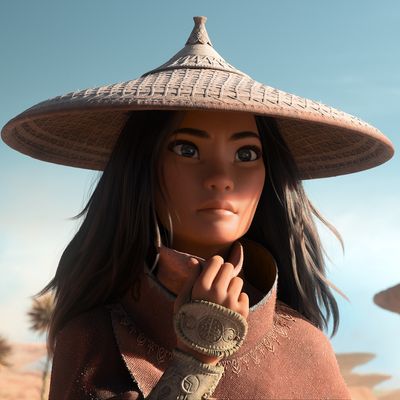
As Disney enters its ninth decade of animated features, the company’s been making gestures toward sociopolitical relevance in addition to repositioning its princesses as independent heroines and opening its animated universes up to be more inclusive. Zootopia was an unmistakable if imperfect allegory about racism; the Frozen sequel pitted its royal sisters against their own kingdom’s colonialist legacy. But however intentional the timing, Raya and the Last Dragon is on a level all its own — a dystopian saga that feels disorientingly primed for a release at the tail end of the pandemic, under a president who ran under messages of healing and unity. It’s a movie that takes place in a landscape ravaged by a plague, and one in which, we’re told, the only chance at a future appears to depend on its characters figuring out how to overcome the tribalism that’s splintered their nation. Who could ever relate? Thank God there’s a cute baby to focus on.
Raya and the Last Dragon, which was directed by Don Hall (of Big Hero 6 and Moana) and Carlos López Estrada (Blindspotting), and written by Qui Nguyen and Adele Lim, is a slick production, as much an action movie as a fantasy adventure. Raya (Kelly Marie Tran) isn’t just the future leader of her land, she’s also a fierce martial artist who’s been training to inherit the role of protector of the gem containing the last of the era’s magic. All parallels to pleas for bipartisanship aside, there’s a genuine emotional heft to the conflict at its center. Raya has to travel to different lands collecting magical objects and evading dangers that range from grandmotherly mob bosses to bugs with exploding farts — but her real battle involves learning to let go of her rage after having been betrayed. Trust, the movie suggests, is an act of grace, something that involves relinquishing the memories of past harm, and something that must be given if it is expected from others.
The angel on her shoulder urging her toward forgiveness is Sisu (Awkwafina), the last dragon, and the one who, the story goes, saved the world from being destroyed by the Druun by creating the gem that Raya and her family have been guarding. The Druun are part virus, part monster, formless forces that transform everyone they come into contact with to stone. When the Druun were first defeated, 500 years ago, their victims transformed back — except for the dragons, the source of all of Kumandra’s enchantments, who remained frozen. When Raya and the Last Dragon begins, Raya’s father, Chief Benja (Daniel Dae Kim), is hoping to heal the rifts between the five warring lands that Kumandra has split into by inviting the leadership for a sit-down. Instead, Namaari (Gemma Chan), the daughter of a rival chief, befriends Raya in order to steal the gem, a double cross that leads to it being shattered and the Druun being set free once again. Six years later, Raya’s desperately chasing a legend that holds that Sisu is still around — and, it turns out, she is, though she’s more goofball than powerhouse.
There’s a cute kid, too — an entrepreneurial junior restaurateur named Boun (Izaac Wang) who specializes in shrimp congee. Benedict Wong voices Tong, another character picked up along the journey, a burly warrior with a squishy center. There’s also the adorable requisite animal sidekick, Tuk Tuk, who’s kind of a roly-poly bug by way of an armadillo, and who can handily serve as an all-terrain mount for the film’s resolute title character when curled up into a ball. Raya and the Last Dragon is a reminder of the things that Disney has always been capable of doing so well at its heights, a marvel of character design, world-building, and canny choices. It unfurls a richly realized Southeast Asia–inspired fantasy realm called Kumandra, made up of craggy deserts, snowy bamboo forests, floating markets, and canal-shielded cities.
There’s a lot of backstory to hurry through, enough to make it easy to see Raya and the Last Dragon as a strategically calculated, spinoff-ready bit of corporate IP that will come back to these details in some other form. But the film has bursts of real transcendence despite that. Sisu, who embodies what at first seems like naïveté, and later a radical optimism, is responsible for many of them. Awkwafina’s gently comedic vocal performance does a lot to establish the character as a holy innocent, joyfully using the powers she accrues to bounce through the sky and always insisting that the right gift can mend all divisions. Namaari is key to the others. Her borderline romantically charged conflict with Raya becomes the central relationship of the movie, with the pair torn between feeling like they can only look out for their own people and a desire to act on behalf of the greater good.
The two young women may be enemies, but they share a capacity for wonder, especially when it comes to dragons. The film’s highlight isn’t a fight sequence, but a moment in which Namaari has an encounter that reminds her that the world is not all a struggle for survival — that it still has the capacity to surprise and to offer hope. It’s moving not because it’s topical, but because the unguarded expression on her face feels so true.





